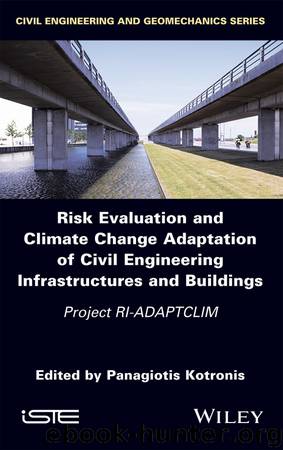Risk Evaluation and Climate Change Adaptation of Civil Engineering Infrastructures and Buildings by Panagiotis Kotronis

Author:Panagiotis Kotronis
Language: eng
Format: epub
ISBN: 9781119671435
Publisher: Wiley
Published: 2019-10-05T00:00:00+00:00
Figure 2.8. Separation from soil according to loading rate
Consequently, differences observed between p—y curves developed for different loading rates can be attributed to the evolution of the gap around the foundation, which, in turn, depends on the loading rate. In addition, when the loading rate becomes very high (in practice, greater than 100k), the reaction curve becomes independent of the rate, inasmuch as the displacement of the pile induces no separation.
Effect of soil anisotropy
The reaction curves modeled by the constitutive law presented in the first part, which is anisotropic, are compared in this section to those modeled by the modified Cam-Clay (MCC) isotropic constitutive law (Roscoe and Burland 1968). The developed constitutive law can be reduced to the MCC by disabling the state variable α that controls the evolution of soil anisotropy as well as destructuration parameters ξ and pb.
Download
This site does not store any files on its server. We only index and link to content provided by other sites. Please contact the content providers to delete copyright contents if any and email us, we'll remove relevant links or contents immediately.
| Automotive | Engineering |
| Transportation |
Whiskies Galore by Ian Buxton(41535)
Introduction to Aircraft Design (Cambridge Aerospace Series) by John P. Fielding(32892)
Small Unmanned Fixed-wing Aircraft Design by Andrew J. Keane Andras Sobester James P. Scanlan & András Sóbester & James P. Scanlan(32576)
Craft Beer for the Homebrewer by Michael Agnew(17936)
Turbulence by E. J. Noyes(7704)
The Complete Stick Figure Physics Tutorials by Allen Sarah(7144)
Kaplan MCAT General Chemistry Review by Kaplan(6601)
The Thirst by Nesbo Jo(6442)
Bad Blood by John Carreyrou(6281)
Modelling of Convective Heat and Mass Transfer in Rotating Flows by Igor V. Shevchuk(6227)
Learning SQL by Alan Beaulieu(6039)
Weapons of Math Destruction by Cathy O'Neil(5837)
Man-made Catastrophes and Risk Information Concealment by Dmitry Chernov & Didier Sornette(5655)
Digital Minimalism by Cal Newport;(5394)
Life 3.0: Being Human in the Age of Artificial Intelligence by Tegmark Max(5193)
iGen by Jean M. Twenge(5164)
Secrets of Antigravity Propulsion: Tesla, UFOs, and Classified Aerospace Technology by Ph.D. Paul A. Laviolette(4999)
Design of Trajectory Optimization Approach for Space Maneuver Vehicle Skip Entry Problems by Runqi Chai & Al Savvaris & Antonios Tsourdos & Senchun Chai(4845)
Electronic Devices & Circuits by Jacob Millman & Christos C. Halkias(4751)
